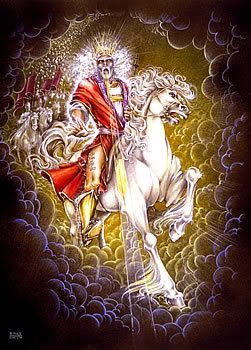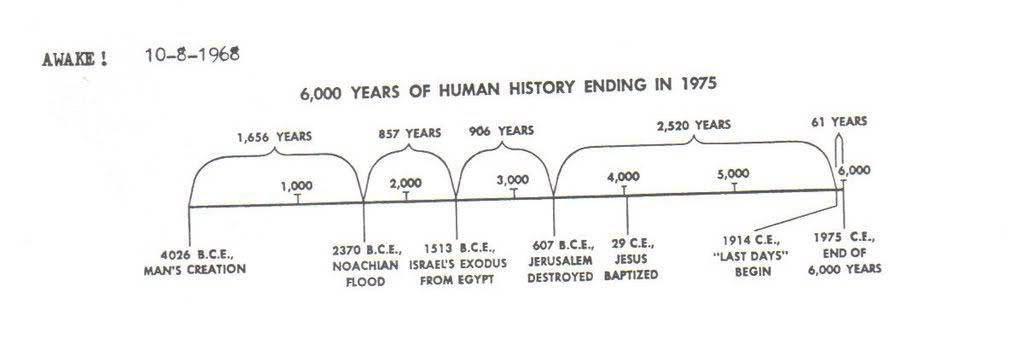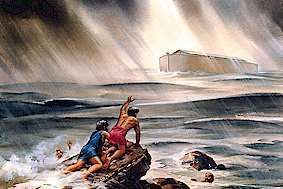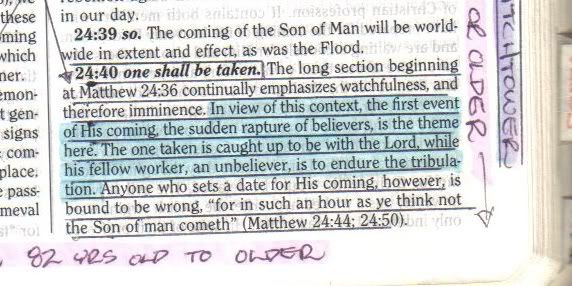Conversations from the Break-Room (II)
Guiding Verse
Daniel 9:27 -- “He will confirm a covenant with many for one ‘seven.’ In the middle of the ‘seven’ he will put an end to sacrifice and offering. And on a wing of the temple he will set up an abomination that causes desolation, until the end that is decreed is poured out on him.” (NIV).
Clarification
Okay, I want to first make the point that this blog stems from a conversation between a co-worker and I, a fellow believer. Another point I wish to establish up-front is that the discussion here has nothing to do with salvation. In other words, we are not saved on the basis of our beliefs in amillennialism, postmillennialism, or premillinialism; we are saved by the grace of God through the finished work on the Cross alone.
This is the reasoning behind denominations. Baptists, Methodists, Lutherans, Four-Square, and the like… we are all on the same page on what Christ’s sacrifice meant for us on that fateful March day. However, some prefer baptism as a child versus as an adult. While we may make a bigger deal out of the non-essentials (as is the tendency of human nature… any married person will tell you that) we are truly only saved by the essentials, that is, a personal relationship with our Maker, this personal relationship is offered by no other religious philosophy.
Okay, that being said let us continue on. I will make a few points and then post a few commentaries on the matter.
Searching for a Common Denominator
I want to find a main common denominator between the views of post, pre, and mid tribulation’ers that we can use as a referent. For those who do not know much about the rapture and the tribulation, you may be a bit lost, sorry. Basically what I am referring to is a seven year period where the anti-Christ will come and reign first peaceably, then with more tyrannical force. It has to do with allusions to the “Four Horsemen” of Revelations, and prophecies stemming from Daniel, Amos, Isaiah, Ezekiel, Zephaniah, Malachi, Zachariah, Jeremiah, Joel, Matthew, Mark, Thessalonians, and the like. I am concerned more in this prose with the verse in Daniel (top) and the “surprise” of Jesus Second Coming.
Warning
Remember, I am not predicting when He is coming, again, only that His coming will be a surprise. Some have tried to predict the coming of Christ, some even as of late, the below is just a few examples, the first is from the back cover of Harold Camping’s books, the other two are from Jehovah's Witnesses publications. (Click on them to enlarge.)
The first example though is one that “gets me.” There is a signature on the inside cover dated 1993 (I bought it used, since the book was no longer useful to whomever owned it when the ball fell in New York on January 1st, 2005… not good marketing either for a product such as a book being purchased for its “relevance factor”) and I often wonder if this book was given by some overzealous Christian to a non-believer as “proof” of his faith… and after 1994 came-and-went if this person the Christian person first meant to proselytize now turned away from what true Christianity has to offer a person.
So the caution here is for the Christian to not call dates in the future based on anything but the signing of the contract between
Commentary Quotes
Back to Daniel 9:27 and what a few commentaries have to say about it:
Charles F Pfeiffer, The Wycliffe Bible Commentary: Old Testament, Dan 9:27
The evil and destructive events described in the remainder of this verse should be interpreted as summary information concerning the final “time of Jacob’s trouble” (Jer 30:7 and context) set forth rather more fully in 12:1 ff; II Thess 2:1 ff; Rev 13; 14; and other passages.
Robert B Hughes, Laney, J. Carl, Tyndale Concise Bible Commentary (The Tyndale Reference Library), p. 319
The seventy weeks begin with the “command” to “rebuild
After the sixty-nine weeks (the 62 + 7), the Messiah would be “killed” (Dan. 9:26), an apparent reference to his crucifixion, and “the city and the
Some commentators make a connection with Daniel 9:27 and the prophesies of the New Testament concerning the “end-times.”
Jesus on History
Jesus spoke on this issue as well. In Mark 13:14 Jesus mentions the verses in Daniel 9:27 and 11:31 when He says:
“When you see ‘the abomination that causes desolation’ standing where it does not belong – let the reader understand….” (NIV).
So Jesus makes mention that this is a future event and not something that happened in the historical past. Take this knowledge then and apply it to what follows.
Further in Mark 13 Jesus says this (vv. 32-37),
“No one knows about that day or hour, not even the angels in heaven, nor the Son, but only the Father. Be on guard! Be alert! You do not know when that time will come. It’s like a man going away: He leaves his house and puts his servants in charge, each with his assigned task, and tells the one at the door to keep watch. “Therefore keep watch because you do not know when the owner of the house will come back—whether in the evening, or at midnight, or when the rooster crows, or at dawn. If he comes suddenly, do not let him find you sleeping. What I say to you, I say to everyone: ‘Watch!’ ” (NIV)
Common Denominator Found
If the tribulation is seven years, and we (pre, post, mid) can all agree that Jesus Second coming is at the end of the seven year tribulation. And we know from Revelations and Daniel that the anti-Christ come in at first as a peacemaker and then half way through causes the Abomination of Desolation, what are we to conclude?
Time Known?
Daniel does seem to have a “covenant” of some sort in mind; a cease fire/peace treaty would fit well with our current political way of handling such situations. So if we know the tribulation starts at the signing… or even if you reject the signing interpretation, at the time of the “abomination that causes desolation” you would know that there are three-and-a-half years left until the end of the tribulation.
SURPRISE!
Jesus’ admonitions, then, do not fit well in the frame work of a post-tribulationist very well. Below is a swath from Matthew chapter 24, it is verses 38-50 that will make my point even more forcibly:
“As it was in the days of Noah, so it will be at the coming of the Son of Man. For in the days before the flood, people were eating and drinking, marrying and giving in marriage, up to the day Noah entered the ark; and they knew nothing about what would happen until the flood came and took them all away. That is how it will be at the coming of the Son of Man. Two men will be in the field; one will be taken and the other left. Two women will be grinding with a hand mill; one will be taken and the other left “Therefore keep watch, because you do not know on what day your Lord will come. But understand this: If the owner of the house had known at what time of night the thief was coming, he would have kept watch and would not have let his house be broken into. So you also must be ready, because the Son of Man will come at an hour when you do not expect him. “Who then is the faithful and wise servant, whom the master has put in charge of the servants in his household to give them their food at the proper time? It will be good for that servant whose master finds him doing so when he returns. I tell you the truth, he will put him in charge of all his possessions. But suppose that servant is wicked and says to himself, ‘My master is staying away a long time,’ and he then begins to beat his fellow servants and to eat and drink with drunkards. The master of that servant will come on a day when he does not expect him and at an hour he is not aware of.
I will now place the scanned notes from this section taken from my study Bible:
Dilemma
So, we have a dilemma here. If we know that Jesus Second Coming is 7-years after the peace treaty between
Another question I have always asked is why would two people be working in the fields and two in the mill if all the armies of the world were gathered and you already had half of the earth’s population destroyed via what looks like in Scripture to be a nuclear exchange and other calamities? I would think the analogy, then, that Jesus would have used would have been two fighting side-by-side (I do not think the “option” for not-fighting in the biggest battle in earth’s history is, well, and option). Or, two women cowering in their homes.
The Christians during the tribulation would be expecting Jesus’ return just in time to stop mankind from annihilating itself at the end of the seven-year period. So the verses on people being taken during a normal business day just doesn’t fit in more than one way
Dilemma Resolved
The best, most logical way then to look at these passages and the others similar to it is to see the pre-tribulation rapture of the church. This would keep the “surprise factor” there, make the servant watchful because he doesn’t know the return of his Master and would explain why the “Church” is not mentioned in Revelations after chapter four.
This is a layman’s understanding of the evidence for the pre-tribulation. It is simple and straightforward to understand, no deep theological degrees are needed to follow this linear thinking. I will leave the more technical aspects of this to the commentary below.
Much Thought,
Papa Giorgio
The New American Commentary on Daniel by Stephen R Miller
(6) Events of the Seventieth Seven (9:27)
9:27 Daniel here described “the completion of God’s purpose.”774 As previously explained, a “seven” represents seven years, and the seventy sevens are terminated by the second advent of Christ. Therefore the events of the seventieth seven transpire over a seven-year period immediately prior to the Lord’s return.
If the sixty-nine sevens (483 years) conclude with Christ’s first coming and the final seven (seven years) is terminated by Christ’s return, there must be an interval of time between the end of the sixty-ninth and the beginning of the seventieth seven. The text also indicates that the seventieth seven would not follow the sixty-ninth immediately. For example, Christ’s crucifixion (“Anointed One … cut off,” v. 26) and the subsequent destruction of
Not only are gaps between first and second coming events common, but the two thousand year span (at least) found here may also be explained by the nature of this revelation. God was answering Daniel’s prayer, which specifically concerned the future of the nation
The events of the last seven will begin with a covenant. Young argues that the one making the covenant will be the “Anointed One” (Jesus Christ) of v. 26 and that the clause should be translated as, He “will cause to prevail” a covenant.777 By this Young means that Christ “fulfilled the terms of this Covenant of Grace, that upon the basis of His finished work, life and salvation might be freely offered to sinners.”778 Young also believes that the “end to sacrifice and offering” spoken of as occurring in the middle of the final seven was brought about by Christ’s death.779 The Old Testament sacrificial system came to an end since the sacrifice they typified, that of Jesus Christ, had been offered. Christ’s death, it is agreed, did end the need for the sacrificial system, but the question is whether that truth is taught in this verse. Most scholars believe it is not.
As for the end of the seventieth seven, Young declares that it will “run out” at least by A.D. 70, but he does not know exactly when. “It would seem, therefore, that the terminus ad quem was not regarded as possessing particular importance or significance.”780 In reality the end of this final seven is one of the most significant events in history, the second coming of Christ.
Young’s identification of Jesus Christ as the perpetrator of this covenant is not supported by the context. The text indicates that this covenant is confirmed (even Young’s translation “prevailed,” which is almost certainly incorrect here, would not relieve this problem) for one seven. Most naturally this is taken to mean that the person in question makes a covenant that “lasts” for seven years. Christ did not institute a covenant that continued merely for seven years, for even Young holds that this final period ended sometime not too many years after the Lord’s death. Christ’s covenant with believers endures forever. Finally, if this seven immediately precedes the end of the age, as most scholars hold, the pronoun “he” cannot refer to Christ’s appearance at his first coming but must speak of someone living in the last days.
The majority of scholars correctly hold that “he” denotes the “ruler” spoken of in the previous verse,781 and Archer points out that “normally the last eligible antecedent is to be taken as the subject of the following verb.”782 Moreover, the context of the passage and the book as a whole supports this identification. His behavior and ultimate doom match that of the “little horn” described in chap. 7—the future ruler of a great empire in the last days and the persecutor of the saints—the Antichrist (so Archer, Wood, Whitcomb, Keil, Leupold). The term “confirm” can mean “make strong” (Ps 12:4, “triumph”) and with bĕrît, “covenant,” here seems to mean “make a firm agreement.”783
This agreement will be made with “many” (lit., “the many”). Walvoord believes the phrase “the many” refers to unbelieving Jews,785 whereas Archer786 and Young787 contend that these are “true believers,” the likely meaning of the expression in Isa 53:11–12. In this context, however, “the many” is best taken as a description of the Jewish people as a group, the nation of
Antichrist, on behalf of his empire, will make a treaty with the nation of
“In the middle of the seven” the Antichrist “will put an end to [šābat] sacrifice and offering.” This event takes place after three and one-half years. The seventieth seven is commonly referred to as the tribulation period, and the second half of this seven is known as the great tribulation (Rev 7:14; cf. Matt 24:21). It is in this last part of the tribulation that the Antichrist persecutes believers and commits other atrocities. The length of the great tribulation, three and one-half years, is spoken of several times in Scripture and should be taken literally (cf. 7:25; Rev 11:2; 12:14; 13:5). Whitcomb notes: “The clarification provided here is that the three and one-half years of 7:25 follow an initial three-and-one-half-year period at the beginning of which the Antichrist” will make a treaty with
That there will be “an end to sacrifice and offering”790 does not necessarily mean that the sacrificial system will be reinstituted in
The NIV’s translation would indicate that Antichrist will place some kind of object (“abomination”) in the temple precincts (“on a wing of the temple”) that will be offensive to the Jews and cause them not to worship there (“causes desolation”). “Of the temple” is placed in brackets by the NIV translators, showing that it is not in the Hebrew text. The NIV’s interpretation (followed by Montgomery)793 is possible but would seem unlikely since “wing” (kānāp) is not found elsewhere in the Old Testament referring to a part of a building or building complex.794 Moreover, “abomination” is plural (“abominations”) in the Hebrew so that if taken with “desolation” it would literally read “abominations of desolation” rather than “abomination of desolation” as in 11:31 and 12:11. The NIV and NRSV have followed the Greek versions in translating “abomination” (singular), probably reflecting an attempt to make the phrase conform to later passages (11:31; 12:11). It is true that some sort of offensive object or objects will be placed in the temple by Antichrist (cf. 12:11; Matt 24:15),795 but it is best not to force that meaning here.
A literal rendering of the Hebrew text is, “And on the wing of796 abominations one who causes desolation [will come].” It seems best to understand “on the wing of abominations” with the KJV as a figure for “overspreading abominations,” that is, great abominations or wickedness. “Wing” is used in a destructive sense in Isa 8:8 as well. Concerning “abominations,”
“One who causes desolation” (similar to NASB) refers to the Antichrist, who will forbid worship and thereby make the temple area desolate (empty). Rather than being an object that desolates in this context, it appears to be the Antichrist himself who desolates. This person’s terrible atrocities (“abominations”) and the fact he causes the temple to be desolate (because of his religious persecution) results in the judgment announced in the latter part of the verse.
This will be a terrible period in the world’s history, but the Lord has “decreed” that these atrocities will not continue forever. Antichrist’s wickedness will last only “until the end that is decreed is poured out on him.” “Poured out” picturesquely describes the flood of judgment that will overtake the Antichrist (cf. 7:9–11, 26; 2 Thess 2:8; Rev 19:19–21). “On him” is literally “on the desolating one” (“desolator,” NRSV; Heb. šōmēm), a reference to Antichrist, which will cause the temple to become desolate.
Daniel’s message of the seventy sevens is one of the greatest prophecies in the Bible. Leupold calls it “the divine program for the ages.”798 Regardless of disagreement over dates and some matters of interpretation, certain facts seem clear. The passage predicts the coming of the Messiah—Jesus of Nazareth. Messiah will die, and subsequently the city of
If the root of מֻעָף is עוּף, the translation would be “having been caused to fly.” This makes good sense, but flying “in weariness” would not since an angel would not grow tired. Thus Young’s translation “to fly in weariness” seems impossible (Prophecy of Daniel, 190).
775 So Hoehner, “Chronological Aspects of the Life of Christ: Part VI: Daniel’s Seventy Weeks and the New Testament Chronology,” 59; R. H. Gundry, The Church and the Tribulation (Grand Rapids: Zondervan, 1973), 190.
781 Maccabean date scholars generally take it to have been the same person, although they believe it was Antiochus IV (cf. Montgomery, Daniel, 385).
788 Cf. Wood, Daniel, 259. Antiochus’s policies seem clearly to have been acceptable only to a minority in
790 Maccabean date scholars maintain that the passage describes the forced cessation of temple worship by Antiochus IV.
792 See the article by R. N. Ostling in which he reports that many Jews in
793 Montgomery, Daniel, 385, 387. Of course,







